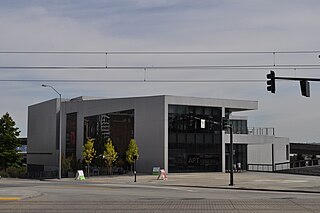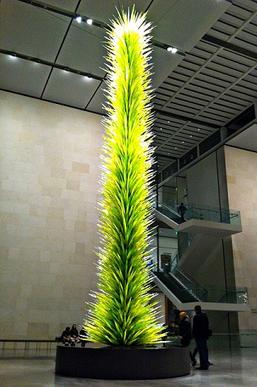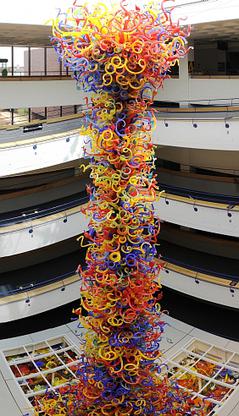
Dale Chihuly is an American glass artist and entrepreneur. He is well known in the field of blown glass, "moving it into the realm of large-scale sculpture".

The Museum of Glass (MOG) is a 75,000-square-foot (7,000 m2) contemporary art museum in Tacoma, Washington, dedicated to the medium of glass. Since its founding in 2002, the Museum of Glass has been committed to creating a space for the celebration of the studio glass movement through nurturing artists, implementing education, and encouraging creativity.

Fairchild Tropical Botanic Garden is an 83-acre (34 ha) botanic garden with extensive collections of rare tropical plants including palms, cycads, flowering trees, and vines. It is located in the city of Coral Gables, Miami-Dade County, just south of Miami, surrounded at the north and west by Matheson Hammock Park.

Phipps Conservatory and Botanical Gardens is a botanical garden set in Schenley Park, Pittsburgh, Pennsylvania, United States. It is a City of Pittsburgh historic landmark and is listed on the National Register of Historic Places.
Pilchuck Glass School is an international center for glass art education. The school was founded in 1971 by Dale Chihuly, Ruth Tamura, Anne Gould Hauberg (1917-2016), and John H. Hauberg (1916-2002). The campus is located on a former tree farm in Stanwood, Washington, in the United States. The administrative offices are located in Seattle. The name "Pilchuck" comes from the local Native American language and translates to "red water" in reference to the Pilchuck River. Pilchuck offers one-, two-, or three-week resident classes each summer in a broad spectrum of glass techniques. They also offer residencies for emerging and established artists working in all media.

The Tacoma Art Museum (TAM) is an art museum in Tacoma, Washington, United States. It focuses primarily on the art and artists from the Pacific Northwest and broader western region of the U.S. Founded in 1935, the museum has strong roots in the community and anchors the university and museum district in downtown Tacoma.

The Toledo Museum of Art is an internationally known art museum located in the Old West End neighborhood of Toledo, Ohio. It houses a collection of more than 30,000 objects. With 45 galleries, it covers 280,000 square feet and is currently in the midst of a massive multiyear expansion plan to its 40-acre campus. The museum was founded by Toledo glassmaker Edward Drummond Libbey in 1901, and moved to its current location, a Greek revival building designed by Edward B. Green and Harry W. Wachter, in 1912. The main building was expanded twice, in the 1920s and 1930s. Other buildings were added in the 1990s and 2006. The museum's main building consists of 4 1/2 acres of floor space on two levels. Features include fifteen classroom studios, a 1,750-seat Peristyle concert hall, a 176-seat lecture hall, a café and gift shop. The museum averages some 380,000 visitors per year and, in 2010, was voted America's favorite museum by the readers of the visual arts website Modern Art Notes.
Italo Scanga, an Italian-born American visual artist, and educator. He was known for his sculptures, ceramics, glass, prints and, paintings, working as a neo-Dadaist, neo-Expressionist, and neo-Cubist; his art was mostly created from found objects and/or ordinary objects. Scanga taught for many years at the University of California, San Diego.

Jack Lenor Larsen was an American textile designer, author, collector and promoter of traditional and contemporary craftsmanship. Through his career he was noted for bringing fabric patterns and textiles to go with modernist architecture and furnishings. Some of his works are part of permanent collections at prominent museums including Museum of Modern Art, Victoria and Albert Museum, Art Institute of Chicago,Musée des Arts Décoratifs at the Louvre, and the Minneapolis Institute of Art, which has his most significant archive.

DNA Tower, a public sculpture by American glass artist Dale Chihuly, is in the Morris Mills Atrium of the VanNuys Medical Science Building, on the campus of Indiana University-Purdue University Indianapolis (IUPUI), which is near downtown Indianapolis, Indiana. It was commissioned for the Indiana University School of Medicine through a gift from an anonymous donor and was dedicated on September 30, 2003.

The Bridge of Glass is a 500-foot (150 m) pedestrian partially-covered footbridge spanning Interstate 705 in Tacoma, Washington. It was opened in 2002 as a gift to the city. The Bridge of Glass connects the Museum of Glass on the Thea Foss Waterway to the downtown and attractions along Pacific Avenue such as Union Station, Washington State History Museum, and Tacoma Art Museum. Together, these attractions make up an area of Tacoma described as "Museum Row." The Bridge of Glass was designed by Texas architect Arthur Andersson and is decorated with artworks by Dale Chihuly. Chihuly has described the Bridge of Glass as "the gateway that welcomes people to Tacoma." It is accessible and free to the public 24 hours a day, lighting up during the nighttime.

Lime Green Icicle Tower is a 2011 glass and steel sculpture by American artist Dale Chihuly. Housed in the Museum of Fine Arts (MFA) in Boston, Massachusetts, it has been on display in the Ruth and Carl J. Shapiro Family Courtyard since the 2011 exhibit "Chihuly: Through the Looking Glass". The sculpture proved so popular during the exhibit that the museum launched a fundraising campaign to purchase the piece.

Fireworks of Glass Tower and Ceiling, also known as Fireworks of Glass, is a blown glass sculpture installation in the permanent collection of The Children's Museum of Indianapolis located in Indianapolis, Indiana, United States of America. The tower sits on a glass base, a pergola ceiling, and rises through the center of the museum's spiraling ramp system. Created by Dale Chihuly in 2006, it is his second-largest permanently installed glass sculpture. Beneath the tower is an accompanying exhibit that describes the sculpture and the process by which it was made. The tower and pergola ceiling are two distinct accessioned objects in the Children's Museum's collection.

Kait Rhoads is an American glass artist. She uses traditional Italian techniques as a base to create public art, sculpture, vessels and jewelry. The aquatic realm is the root of much of her work, the result of spending six years on a boat in the Caribbean in her youth. Since moving to the Northwest over two decades ago, her fascination extended from coral colonies to kelp forests. Aquatic life infuses her sculptures with animated forms, sparkling surfaces and faceted exoskeletons. Rhoads volunteers at the Seattle Aquarium, gaining inspiration and information on ocean ecology first hand on a weekly basis.

Leslie Jackson Chihuly is an American arts executive and philanthropist. She is the president and chief executive officer of Chihuly, Inc., which includes Chihuly Studio and Chihuly Workshop, both of which feature the artistic work and vision of her husband, Dale Chihuly. In 2018, she was elected as chair emerita of the Seattle Symphony Board after serving nine years as board chair and implementing a number of revitalizing changes. Those included filling the roles of CEO and music director with fresh talent, and taking the organization from financial challenge and organizational strife in 2009 to the stage of Carnegie Hall in 2014. Under her leadership, the symphony won three Grammy Awards and the Gramophone “Orchestra of the Year Award” in 2018. Leslie Chihuly serves on the boards of the Seattle Symphony, Vassar College and the Pilchuck Glass School. In 2022, President Joe Biden announced his intention to appoint Jackson Chihuly to the President’s Advisory Committee on the Arts.
Flora C. Mace is an American glass artist, sculptor, and educator. She was the first woman to teach at Pilchuck Glass School. Since the 1970s, her artistic partner has been Joey Kirkpatrick and their work is co-signed. Mace has won numerous awards including honorary fellow by the American Craft Council (2005).
Joey Kirkpatrick is an American glass artist, sculptor, wire artist, and educator. She has taught glassblowing at Pilchuck Glass School. Since the 1970s, her artistic partner has been Flora Mace and their work is co-signed. Kirkpatrick has won numerous awards including honorary fellow by the American Craft Council (2005).

Indigo Blue Seaform with Red Lip Wraps is a blown glass sculpture by Dale Chihuly. It was completed in 1997 and is currently located in Central Library at Vanderbilt University in Nashville, Tennessee. The glass features striations, swirls, and a translucency that mimics the natural beauty of underwater environments.
















